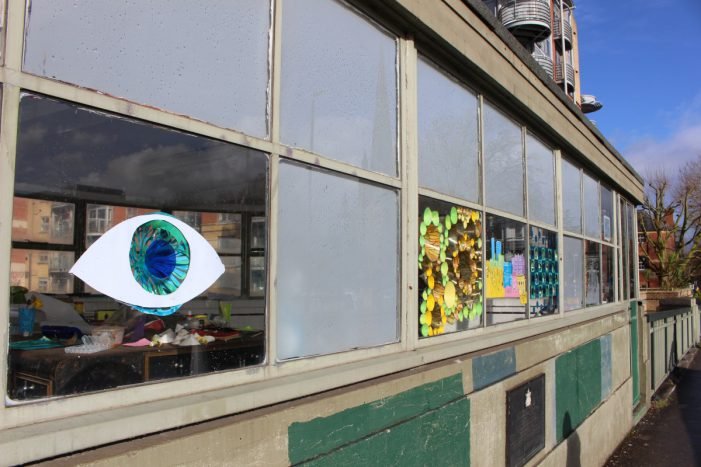The Control Room: A Commission
From the 13th of February to the 31st of March 2017, Rising was commissioned by Bristol City Council to fill the Control Room (Redcliffe Bridge) with artwork by young, emerging artists. So we did!
Each artist had a week using the space as a studio to make and then display work in the windows, using a set toolkit of materials to respond to the theme of ‘Control’.
The participating artists were:
and one other, unnamed, artist.
Read interviews with the artists here.
Their brief was to produce large-scale illustrations in the space using a variety of different mediums, creating striking images on the windows. As the project progressed and the artists handed over to one another, their work became a provocation for the next artist, so that the work changed and grew, week to week, keeping passers-by engaged and intrigued.
THE INTERVIEWS
Jasmine Thompson
Jasmine, the second artist in the series, is a Bristol-based illustrator, writer, and designer. Her work focuses predominantly on social issues and identity, particularly focusing on the city and the people that inhabit it.
How did you respond to the ‘Control Room’s’ brief?
I created cityscapes on the windows of the ‘Control Room’ in response to the theme of control. The illustrations are designed to be from a CCTV camera observing the city and its inhabitants through a lens. We are under constant watch and analysis at all times, constantly feeling like we’re encouraged to be sheep and follow the crowd. There is an element of control within society, and I depict this through incorporating the CCTV camera element into my illustrations.
How do you create your pieces?
I create my pieces with pen and ink on paper and some straight onto the window. I work using simple materials but relatively detailed.
How has your work developed since during this project?
My work has developed from exploring new methods of producing artwork that I normally shy away from. I’ve included collaged work which is something I’m unfamiliar with, but it’s been a fun process.
What has been your biggest hurdle in doing the ‘Control Room’?
My biggest hurdle has been keeping my fingers warm long enough to draw! Generally the space is a great place to work in and a lot of fun though, this is a new experience and I have been fully embracing it.
Vivian Barton
Vivian Barton, a Bristol-based illustrator is the third artist in the series.
How did you respond to the ‘Control Room’s’ brief?
I originally intended to create work around the idea of being able to control how other people perceive you. Specifically within the context of transgender people. but I’m not sure it ended up that way.
How do you create your pieces?
I tend to just scribble down whatever. I try not to think too hard about what I draw and try to keep it as loose as possible. 9/10 times I make something terrible but the tenth drawing is often more interesting than if I had spent a longer time planning it.
What inspires you?
Japanese horror. especially artists like Junji Ito and Shintaro Kago.
How has your work developed since during this project?
This project helped me to think about layout a lot more and also about using the surface as a part of the image by tearing the card and layering the transparent acetate and tracing paper up to create a more visually interesting image.
What has been your biggest hurdle in doing the control room?
The biggest hurdle has been working fast enough since I can’t drive it’s difficult to bring work in so I had to do most of the work at the Control Room and since there are such few facilities there it became difficult to create work that was big enough in the time frame.
With thanks to the Bristol Arts Development Team for the commission, and for playing a leading role in advocating for the arts across the city.

